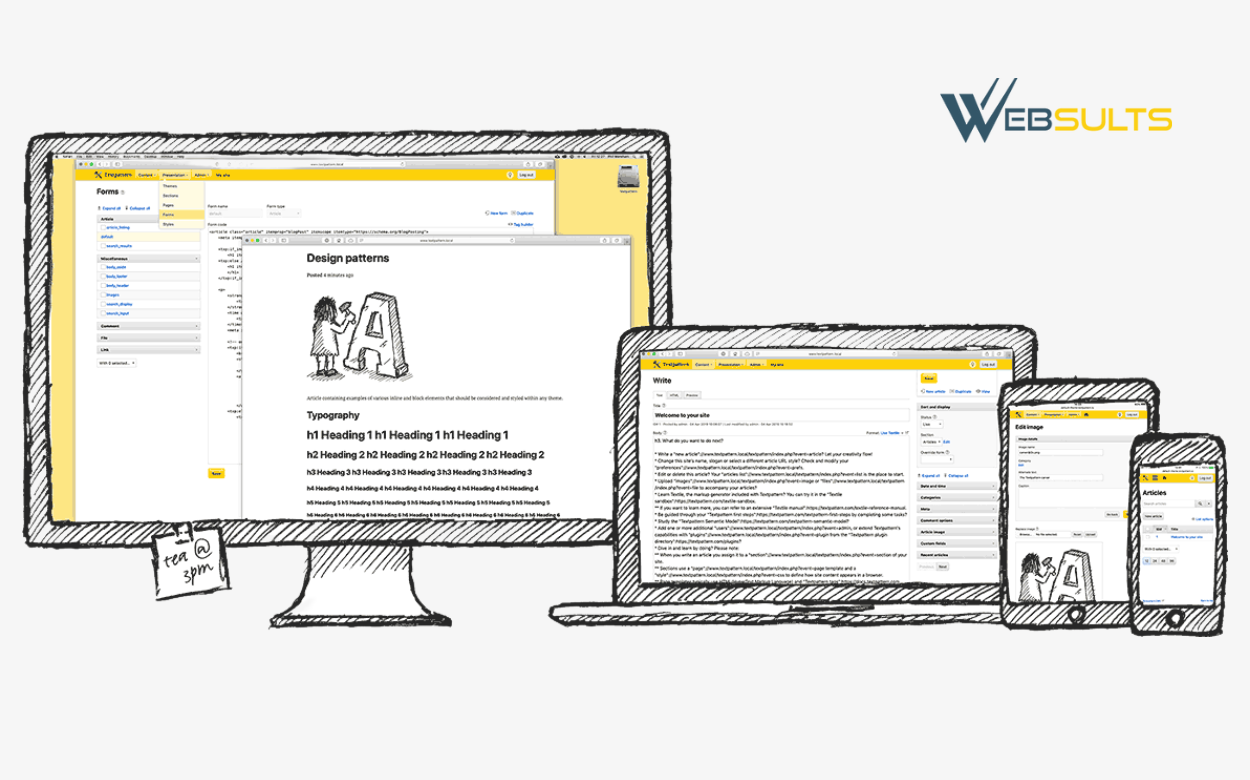Textpattern is approaching its 20th anniversary this year. In this blog, learn everything you need to know about Textpattern and how it compares to the industry-leading competitor, WordPress.
In a sea of endless content management systems (CMS) options, Textpattern stands out as user-friendly, free, open-source software suitable for a range of skill levels. Designed to be both simple and elegant, Textpattern caters to web designers, developers, publishers, and bloggers. Its straightforward nature allows for flexibility and sophistication, letting you remain fully in control of your website’s design and function.
Whether you prefer simplicity or advanced features, Textpattern accommodates both ends of the spectrum. The administration interface provides options to control HTML and CSS, and plugins are available for added functionality. Users can also implement built-in language tags as placeholders to determine how dynamic content is retrieved and displayed.
According to W3Techs, WordPress powers over 43% of all websites, while Textpattern continues to serve a smaller but loyal base of creators who value lightweight architecture, security, and coding control. This makes Textpattern a solid choice for developers who prioritize speed, minimalism, and flexibility over visual builders and pre-packaged templates.
This article is for informational purposes only. For professional marketing or web-development advice, consult an experienced digital agency.
History of Textpattern
Textpattern has humble beginnings. Dean Allen originally crafted the idea as an informal means to publish his personal site, Textism, in 2001. The formal announcement of Textpattern followed in 2003, accompanied by beta and gamma releases aimed at refining its capabilities.
In September 2004, the much-anticipated Release Candidate 1 for Textpattern 1.0 marked its debut, paving the way for successive releases. During this period, Textpattern strengthened its team by welcoming Alex Shiels, Pedro Palazón, and Sencer Yurdagül. In August 2005, the first stable version—Textpattern 4.0—was released.
Over the years, Textpattern introduced administrative plugins, themes, and enhanced core code to expand its functionality. In January 2018, its creator Dean Allen passed away. Later that year, version 4.7.0 was released as a tribute to his legacy.
Today, the Textpattern community on GitHub continues active development, maintaining stability and introducing new features such as PHP 8 support, improved security, and better theme management. Its longevity highlights the resilience of smaller, open-source CMS platforms.
Well-Known Companies That Use Textpattern
While Textpattern may not be as widespread as WordPress, Joomla, or Drupal, it has earned loyal use within academia, publishing, and independent media. The CMS industry is competitive, yet Textpattern retains a niche among creators who prioritize writing and publishing over visual design complexity.
Their official site boldly states, “Textpattern is built for content publishers to just write.” This reflects its purpose: to provide a focused, distraction-free writing experience that keeps words and content at the forefront.
Textpattern’s streamlined nature appeals to smaller organizations and universities that need stable publishing tools without heavy maintenance. Its smaller footprint and minimal codebase often deliver faster loading times, which directly influence SEO performance.
Notable websites using Textpattern include:
- Sheffield Hallam University
- Insight Communications, Corp. (ICOMM)
- Study International
- Digital Marketing Magazine UK
While these sites may not have the same scale as enterprise-level WordPress projects, they show the range of users that appreciate Textpattern’s simplicity and efficiency.
Textpattern vs WordPress Comparison
Although both Textpattern and WordPress serve the same core purpose—content management—they differ in usability, scalability, and flexibility. WordPress has achieved global dominance through its ecosystem of plugins, themes, and community support. Textpattern, on the other hand, retains a smaller yet technically inclined user base focused on clean code and editorial simplicity.
Textpattern vs WordPress Overview
| Feature / Function | Textpattern | WordPress |
|---|---|---|
| Core Purpose | Lightweight CMS for writers and developers | Full-scale CMS for all site types |
| Ease of Use | Minimalist interface; low learning curve | Intuitive dashboard with visual editors |
| Customization | Tag-based templates; manual control | Thousands of plugins and themes |
| Performance | Fast, lean codebase | Can slow down with excess plugins |
| SEO Capabilities | Manual setup or limited plugins | Powerful SEO plugins like Yoast |
| Security | Strong; few attack targets | Requires frequent updates |
| Community Support | Smaller, devoted developer community | Global community with extensive documentation |
| Ideal Users | Writers, coders, and small publishers | Businesses, bloggers, and enterprises |
Textpattern Pros
- Streamlined content organization
- Administrative interface prioritizes writing
- Insert dynamic content using tag builders instead of coding PHP
- Lightweight and fast performance
- Ideal for bloggers and minimalist sites
Textpattern Cons
- Limited templates and plugin ecosystem
- Lack of distinction between posts and pages
- Single template installation at a time
- Smaller support community
WordPress Pros
- User-friendly dashboard
- Regular core and plugin updates
- Highly customizable and scalable
- Vast plugin marketplace
- Often ranks higher in search engines
- Large, reliable support network
WordPress Cons
- Frequent maintenance required
- Plugin overload can affect speed
- Advanced features may require paid extensions
If you’re managing a small blog or personal website, Textpattern can deliver exceptional performance with minimal bloat. For growing businesses and organizations that need scalability, plugin support, and integrated marketing tools, WordPress remains the more powerful option.
Reviews and Testimonials
Even after two decades, Textpattern retains dedicated followers who appreciate its efficiency and simplicity.
“The user interface is easy. One won’t have a hard time removing date fields and so on. However, for WordPress, operations like removing a date field among other modifications need some knowledge of PHP language.” — KnownHost Blog
“Textpattern is starting to show its age and needs to step up on performance and scalability work. It needs to get on top of better image and multimedia management to stay on top of the needs of today’s creative publishers.” — Daniel Aleksandersen, Ctrl.blog
The Open Source CMS Directory lists Textpattern as one of the oldest PHP-based CMS projects still in active development, which reinforces its credibility and sustainability as a long-term solution.
Textpattern Training & Resources
If you’re interested in learning more about Textpattern or want to test its functionality, explore the following resources:
- Official Textpattern Features
- Textpattern GitHub Repository
- Textpattern CMS Official Website
- Textpattern Tutorial Video on YouTube
Websults | SEO Agency Located in Clearwater, FL
At Websults, we primarily develop and optimize client websites using WordPress, but we can also support existing Textpattern projects and assist with CMS migrations. Our expertise spans web design, SEO services, and digital marketing, helping businesses modernize their web presence while maintaining site integrity and performance.
If you’re managing an older Textpattern website and are considering transitioning to WordPress, our team can ensure a seamless conversion process with improved SEO structure, analytics tracking, and responsive design.
Contact Websults for a free website consultation today to learn how we can help you strengthen your digital presence.




